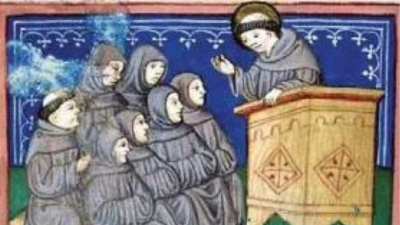Teaching the Brothers
St. Francis of Assisi
As the fraternity grew the new arrivals simply did what Francis did. Eventually Francis wrote something down concerning the spiritual journey of this new life.

The small band of brothers living at Rivo Torto and later at the Porziuncola, were drawing others to their way of following Christ in the world. And if they expected to find a uniform dress code, posted rules, a great deal of organization, a formation program, or even someone to sit them down and explain what was expected – they were in for a surprise. Francis assumed that his followers would learn by imitation. Giving them rules or structures to follow was not merely difficult for him, it went against the grain of the meaning of minority – to be the lesser brother. The new arrivals simply did what Francis did: daily prayer, work at a local leprosarium, go to local churches to participate in Eucharist, eat, pray again, witness to the local Umbrian people near Assisi, and live a life in community. The brothers had to watch Francis closely and do their best to understand.
Very soon however, Francis wrote something down concerning the spiritual journey that the brothers would be undertaking. Those who would follow Francis’ way of following Christ needed to understand that there was a clear demarcation between the former way of sin and that of “leaving the world.” In his Earlier Exhortation, Francis divides the world of people into two categories: “Those Who Do Penance” and “Those Who Do Not Do Penance.” In medieval writing “penance” does not refer primarily to sacramental confession, but to a life directed to conversion to Christ.
Francis listed four characteristics of those who do penance: they “1 love the Lord with their whole heart, with their whole soul and mind, with their strength and love their neighbors as themselves, 2 who hate their bodies with their vices and sins, 3 who receive the Body and Blood of our Lord Jesus Christ, 4 and who produce worthy fruits of penance.” Simply put, Francis expected the penitential life to consist of following the two great commandments, practicing bold asceticism, participating in Eucharist regularly, and doing good works. Francis’ passion shines through this conventional medieval language and transforms this basic path of penance into a mystical journey towards union with God:
“5 O how happy and blessed are these men and women while they do such things and persevere in doing them, 6 because the Spirit of the Lord will rest upon them and make Its home and dwelling place among them, 7 and they are children of the heavenly Father Whose works, they do, and they are spouses, brothers and mothers of our Lord Jesus Christ.
8 We are spouses when the faithful soul is joined by the Holy Spirit to our Lord Jesus Christ. 9 We are brothers to Him when we do the will of the Father who is in heaven. 10 We are mothers when we carry Him in our heart and body through a divine love and pure and sincere conscience and give birth to Him though a holy activity which must shine as an example before others.”
What at first seems to be descriptions of penitential acts of an individual are transformed by Francis’ personal insights into highly relational ways of being described most intimately in terms of familial relationships. Francis describes an inner union in the Spirit with Christ, that converts the will and desire of the person to want with all their being to do the will of the heavenly Father. Francis then radically describes the inner conversion bursting out into the world using the maternal description of child bearing. He incorporates the highly Marian imagery of one being impregnated by the Holy Spirit, the inner gestation of God’s grace that must be carried to a fullness before its birth into action that sets a holy example before others. Francis’ vision is intensely personal and communal at the same time.
And then there are those who do not do penance. Francis’ message to them is terrifyingly stark: they delude themselves and are working their way to eternal damnation: “They are held captive by the Devil, whose children they are, and whose works they do.” In the address to these people, Francis almost seems to recount his own life before conversion: serving the desires of the flesh, lacking wisdom, preferring vice and sin, and chasing life’s vanities and vainglory. And one should remember that in the background of all this is a Europe moving from feudal life to cities, moving from isolation from the world to trade with the exotic Middle and Far East, and moving from land as the measure of wealth to trade and money as competing standards. Francis had been part of the privileged people of Assisi, but had found that life to be void of spiritual sustenance. Hence he offered those who would follow his way, a stark choice – life or death.
Francis seemed to see in his own life the deep chasm between, as he wrote, “When I was in sin…” and God’s superabundant forgiveness. He simply offered the newly arrived brothers a path to follow marked by giving up everything in order to enter unburdened into a relationship with the Triune God who would lead them to a life “loving, gratifying, humbling, peace-giving, sweet, worthy of love.”
It was attractive, it was challenging, and the brothers began to arrive in increasing numbers.